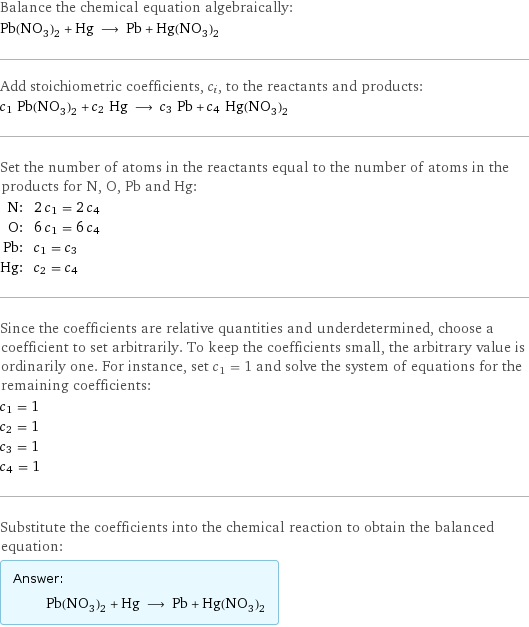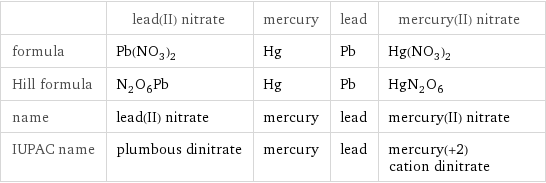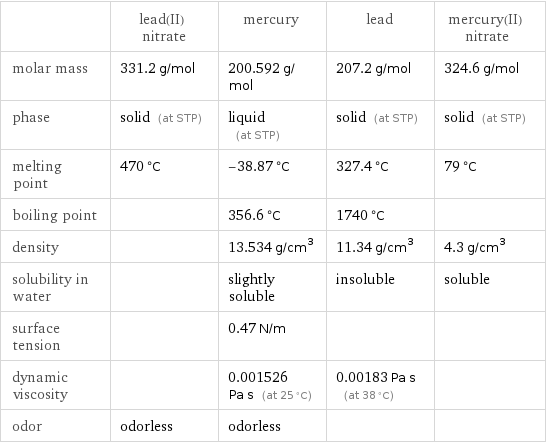Input interpretation

Pb(NO_3)_2 lead(II) nitrate + Hg mercury ⟶ Pb lead + Hg(NO_3)_2 mercury(II) nitrate
Balanced equation

Balance the chemical equation algebraically: Pb(NO_3)_2 + Hg ⟶ Pb + Hg(NO_3)_2 Add stoichiometric coefficients, c_i, to the reactants and products: c_1 Pb(NO_3)_2 + c_2 Hg ⟶ c_3 Pb + c_4 Hg(NO_3)_2 Set the number of atoms in the reactants equal to the number of atoms in the products for N, O, Pb and Hg: N: | 2 c_1 = 2 c_4 O: | 6 c_1 = 6 c_4 Pb: | c_1 = c_3 Hg: | c_2 = c_4 Since the coefficients are relative quantities and underdetermined, choose a coefficient to set arbitrarily. To keep the coefficients small, the arbitrary value is ordinarily one. For instance, set c_1 = 1 and solve the system of equations for the remaining coefficients: c_1 = 1 c_2 = 1 c_3 = 1 c_4 = 1 Substitute the coefficients into the chemical reaction to obtain the balanced equation: Answer: | | Pb(NO_3)_2 + Hg ⟶ Pb + Hg(NO_3)_2
Structures

+ ⟶ +
Names

lead(II) nitrate + mercury ⟶ lead + mercury(II) nitrate
Equilibrium constant
![Construct the equilibrium constant, K, expression for: Pb(NO_3)_2 + Hg ⟶ Pb + Hg(NO_3)_2 Plan: • Balance the chemical equation. • Determine the stoichiometric numbers. • Assemble the activity expression for each chemical species. • Use the activity expressions to build the equilibrium constant expression. Write the balanced chemical equation: Pb(NO_3)_2 + Hg ⟶ Pb + Hg(NO_3)_2 Assign stoichiometric numbers, ν_i, using the stoichiometric coefficients, c_i, from the balanced chemical equation in the following manner: ν_i = -c_i for reactants and ν_i = c_i for products: chemical species | c_i | ν_i Pb(NO_3)_2 | 1 | -1 Hg | 1 | -1 Pb | 1 | 1 Hg(NO_3)_2 | 1 | 1 Assemble the activity expressions accounting for the state of matter and ν_i: chemical species | c_i | ν_i | activity expression Pb(NO_3)_2 | 1 | -1 | ([Pb(NO3)2])^(-1) Hg | 1 | -1 | ([Hg])^(-1) Pb | 1 | 1 | [Pb] Hg(NO_3)_2 | 1 | 1 | [Hg(NO3)2] The equilibrium constant symbol in the concentration basis is: K_c Mulitply the activity expressions to arrive at the K_c expression: Answer: | | K_c = ([Pb(NO3)2])^(-1) ([Hg])^(-1) [Pb] [Hg(NO3)2] = ([Pb] [Hg(NO3)2])/([Pb(NO3)2] [Hg])](../image_source/ad5f14eaff3425395d927e55cc91eb59.png)
Construct the equilibrium constant, K, expression for: Pb(NO_3)_2 + Hg ⟶ Pb + Hg(NO_3)_2 Plan: • Balance the chemical equation. • Determine the stoichiometric numbers. • Assemble the activity expression for each chemical species. • Use the activity expressions to build the equilibrium constant expression. Write the balanced chemical equation: Pb(NO_3)_2 + Hg ⟶ Pb + Hg(NO_3)_2 Assign stoichiometric numbers, ν_i, using the stoichiometric coefficients, c_i, from the balanced chemical equation in the following manner: ν_i = -c_i for reactants and ν_i = c_i for products: chemical species | c_i | ν_i Pb(NO_3)_2 | 1 | -1 Hg | 1 | -1 Pb | 1 | 1 Hg(NO_3)_2 | 1 | 1 Assemble the activity expressions accounting for the state of matter and ν_i: chemical species | c_i | ν_i | activity expression Pb(NO_3)_2 | 1 | -1 | ([Pb(NO3)2])^(-1) Hg | 1 | -1 | ([Hg])^(-1) Pb | 1 | 1 | [Pb] Hg(NO_3)_2 | 1 | 1 | [Hg(NO3)2] The equilibrium constant symbol in the concentration basis is: K_c Mulitply the activity expressions to arrive at the K_c expression: Answer: | | K_c = ([Pb(NO3)2])^(-1) ([Hg])^(-1) [Pb] [Hg(NO3)2] = ([Pb] [Hg(NO3)2])/([Pb(NO3)2] [Hg])
Rate of reaction
![Construct the rate of reaction expression for: Pb(NO_3)_2 + Hg ⟶ Pb + Hg(NO_3)_2 Plan: • Balance the chemical equation. • Determine the stoichiometric numbers. • Assemble the rate term for each chemical species. • Write the rate of reaction expression. Write the balanced chemical equation: Pb(NO_3)_2 + Hg ⟶ Pb + Hg(NO_3)_2 Assign stoichiometric numbers, ν_i, using the stoichiometric coefficients, c_i, from the balanced chemical equation in the following manner: ν_i = -c_i for reactants and ν_i = c_i for products: chemical species | c_i | ν_i Pb(NO_3)_2 | 1 | -1 Hg | 1 | -1 Pb | 1 | 1 Hg(NO_3)_2 | 1 | 1 The rate term for each chemical species, B_i, is 1/ν_i(Δ[B_i])/(Δt) where [B_i] is the amount concentration and t is time: chemical species | c_i | ν_i | rate term Pb(NO_3)_2 | 1 | -1 | -(Δ[Pb(NO3)2])/(Δt) Hg | 1 | -1 | -(Δ[Hg])/(Δt) Pb | 1 | 1 | (Δ[Pb])/(Δt) Hg(NO_3)_2 | 1 | 1 | (Δ[Hg(NO3)2])/(Δt) (for infinitesimal rate of change, replace Δ with d) Set the rate terms equal to each other to arrive at the rate expression: Answer: | | rate = -(Δ[Pb(NO3)2])/(Δt) = -(Δ[Hg])/(Δt) = (Δ[Pb])/(Δt) = (Δ[Hg(NO3)2])/(Δt) (assuming constant volume and no accumulation of intermediates or side products)](../image_source/4e376f1fedcd2bb6aaa137d90b101637.png)
Construct the rate of reaction expression for: Pb(NO_3)_2 + Hg ⟶ Pb + Hg(NO_3)_2 Plan: • Balance the chemical equation. • Determine the stoichiometric numbers. • Assemble the rate term for each chemical species. • Write the rate of reaction expression. Write the balanced chemical equation: Pb(NO_3)_2 + Hg ⟶ Pb + Hg(NO_3)_2 Assign stoichiometric numbers, ν_i, using the stoichiometric coefficients, c_i, from the balanced chemical equation in the following manner: ν_i = -c_i for reactants and ν_i = c_i for products: chemical species | c_i | ν_i Pb(NO_3)_2 | 1 | -1 Hg | 1 | -1 Pb | 1 | 1 Hg(NO_3)_2 | 1 | 1 The rate term for each chemical species, B_i, is 1/ν_i(Δ[B_i])/(Δt) where [B_i] is the amount concentration and t is time: chemical species | c_i | ν_i | rate term Pb(NO_3)_2 | 1 | -1 | -(Δ[Pb(NO3)2])/(Δt) Hg | 1 | -1 | -(Δ[Hg])/(Δt) Pb | 1 | 1 | (Δ[Pb])/(Δt) Hg(NO_3)_2 | 1 | 1 | (Δ[Hg(NO3)2])/(Δt) (for infinitesimal rate of change, replace Δ with d) Set the rate terms equal to each other to arrive at the rate expression: Answer: | | rate = -(Δ[Pb(NO3)2])/(Δt) = -(Δ[Hg])/(Δt) = (Δ[Pb])/(Δt) = (Δ[Hg(NO3)2])/(Δt) (assuming constant volume and no accumulation of intermediates or side products)
Chemical names and formulas

| lead(II) nitrate | mercury | lead | mercury(II) nitrate formula | Pb(NO_3)_2 | Hg | Pb | Hg(NO_3)_2 Hill formula | N_2O_6Pb | Hg | Pb | HgN_2O_6 name | lead(II) nitrate | mercury | lead | mercury(II) nitrate IUPAC name | plumbous dinitrate | mercury | lead | mercury(+2) cation dinitrate
Substance properties

| lead(II) nitrate | mercury | lead | mercury(II) nitrate molar mass | 331.2 g/mol | 200.592 g/mol | 207.2 g/mol | 324.6 g/mol phase | solid (at STP) | liquid (at STP) | solid (at STP) | solid (at STP) melting point | 470 °C | -38.87 °C | 327.4 °C | 79 °C boiling point | | 356.6 °C | 1740 °C | density | | 13.534 g/cm^3 | 11.34 g/cm^3 | 4.3 g/cm^3 solubility in water | | slightly soluble | insoluble | soluble surface tension | | 0.47 N/m | | dynamic viscosity | | 0.001526 Pa s (at 25 °C) | 0.00183 Pa s (at 38 °C) | odor | odorless | odorless | |
Units
